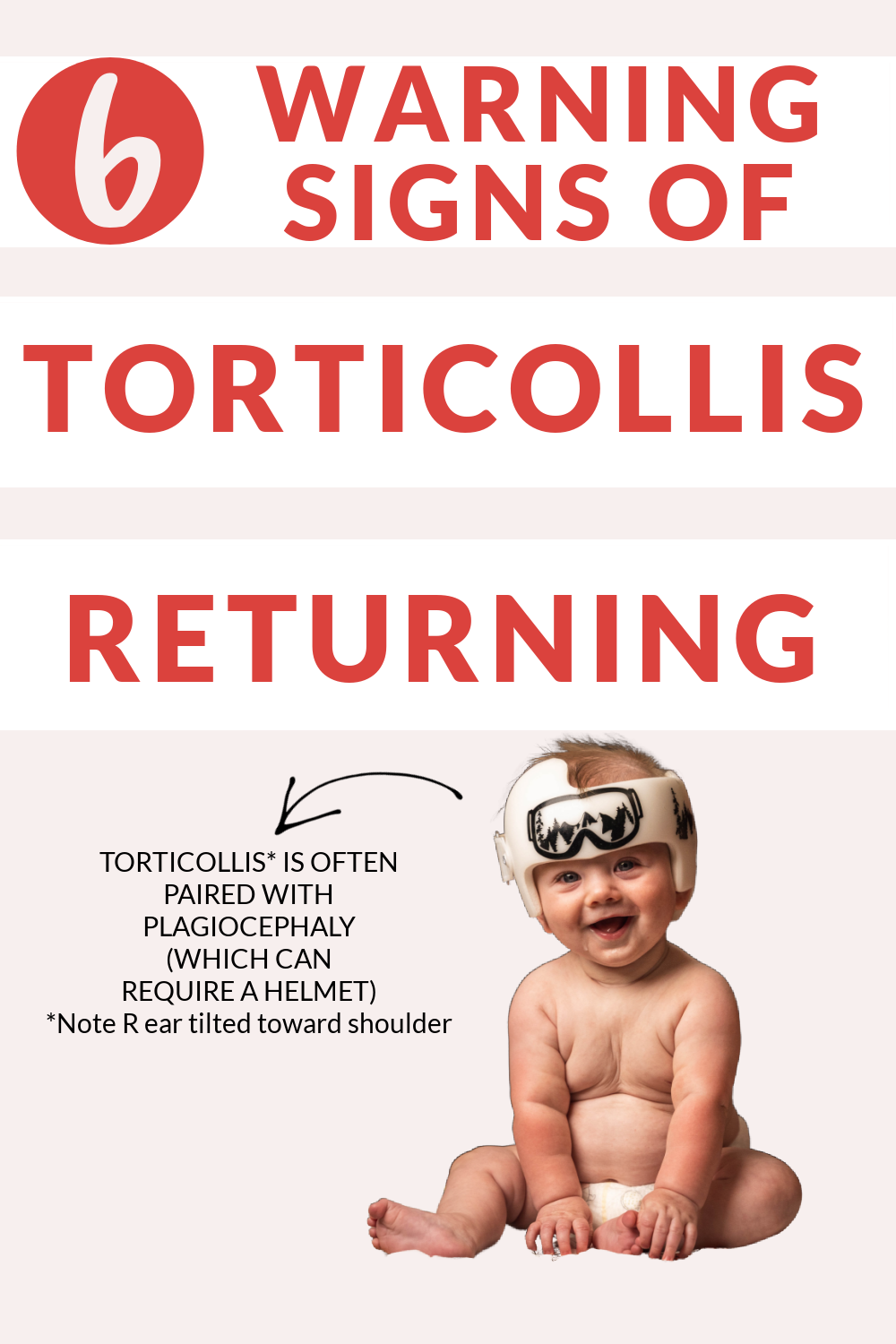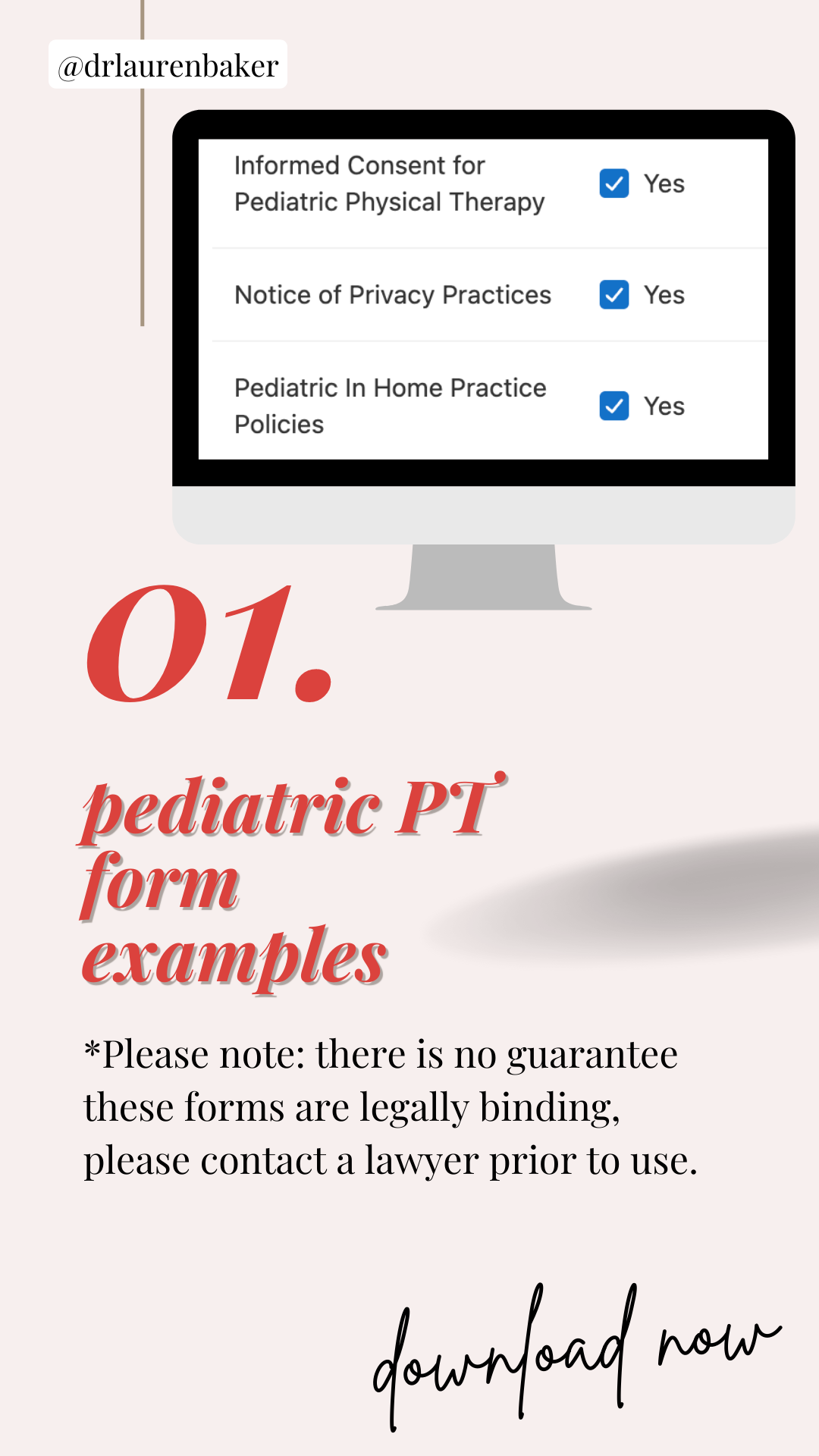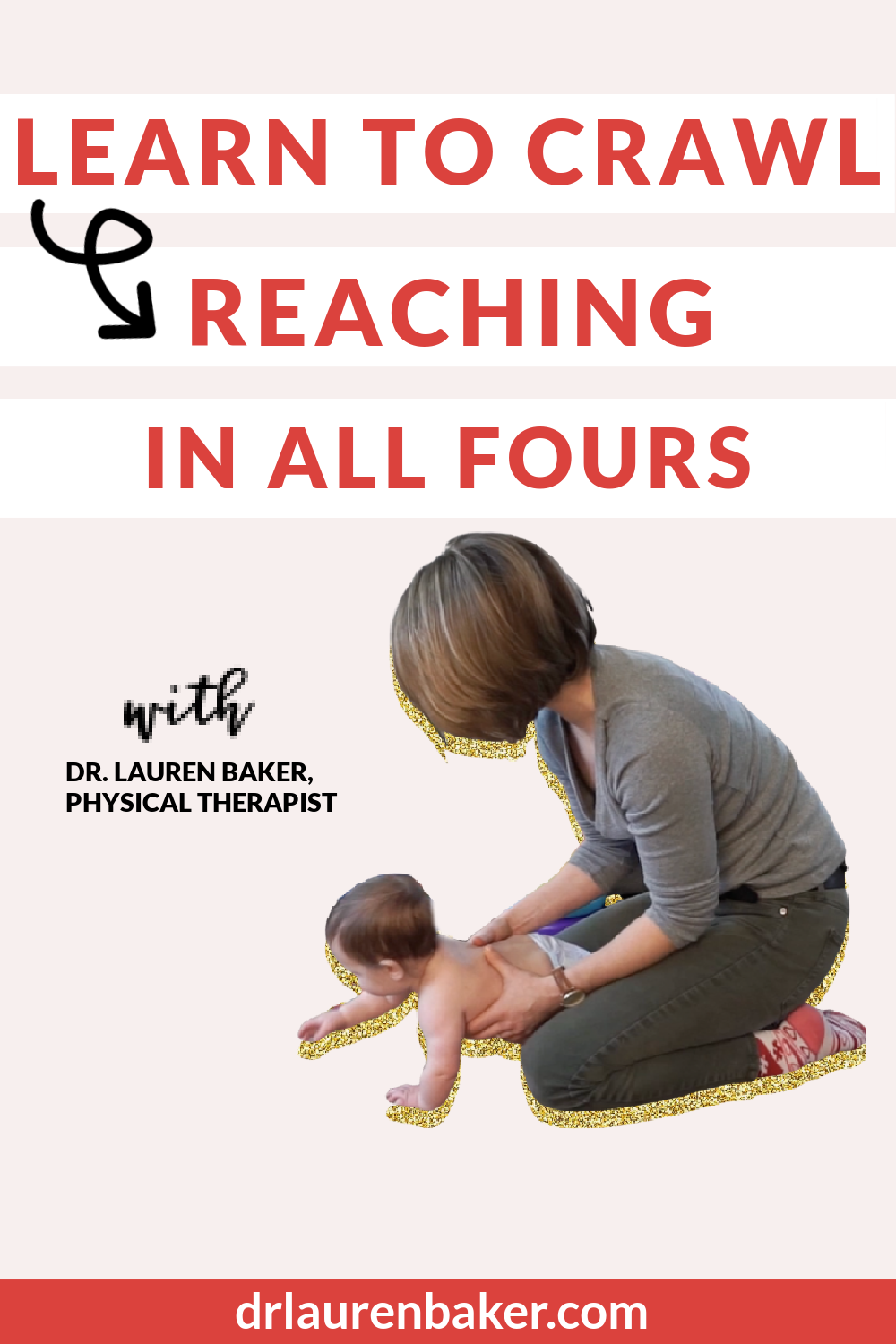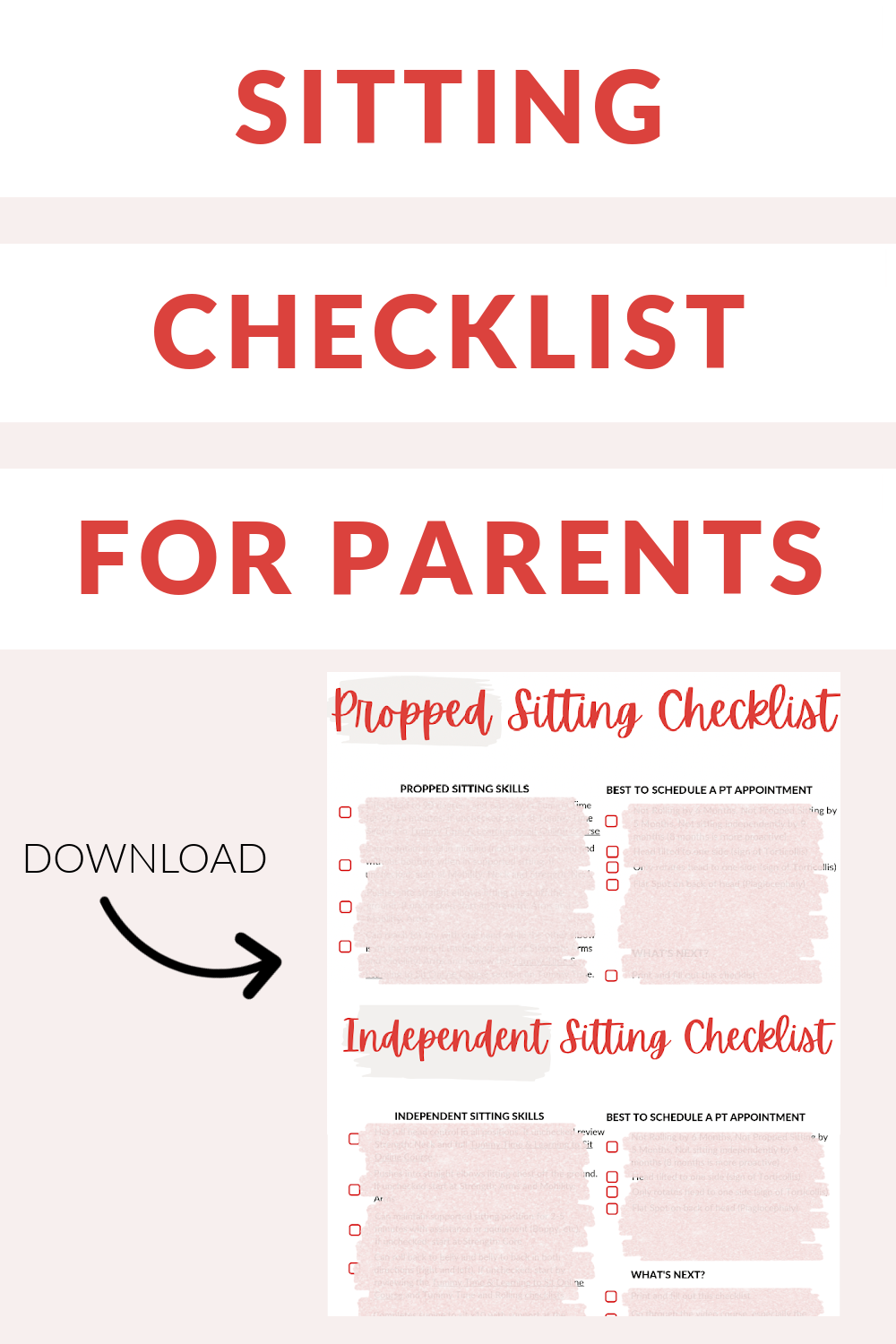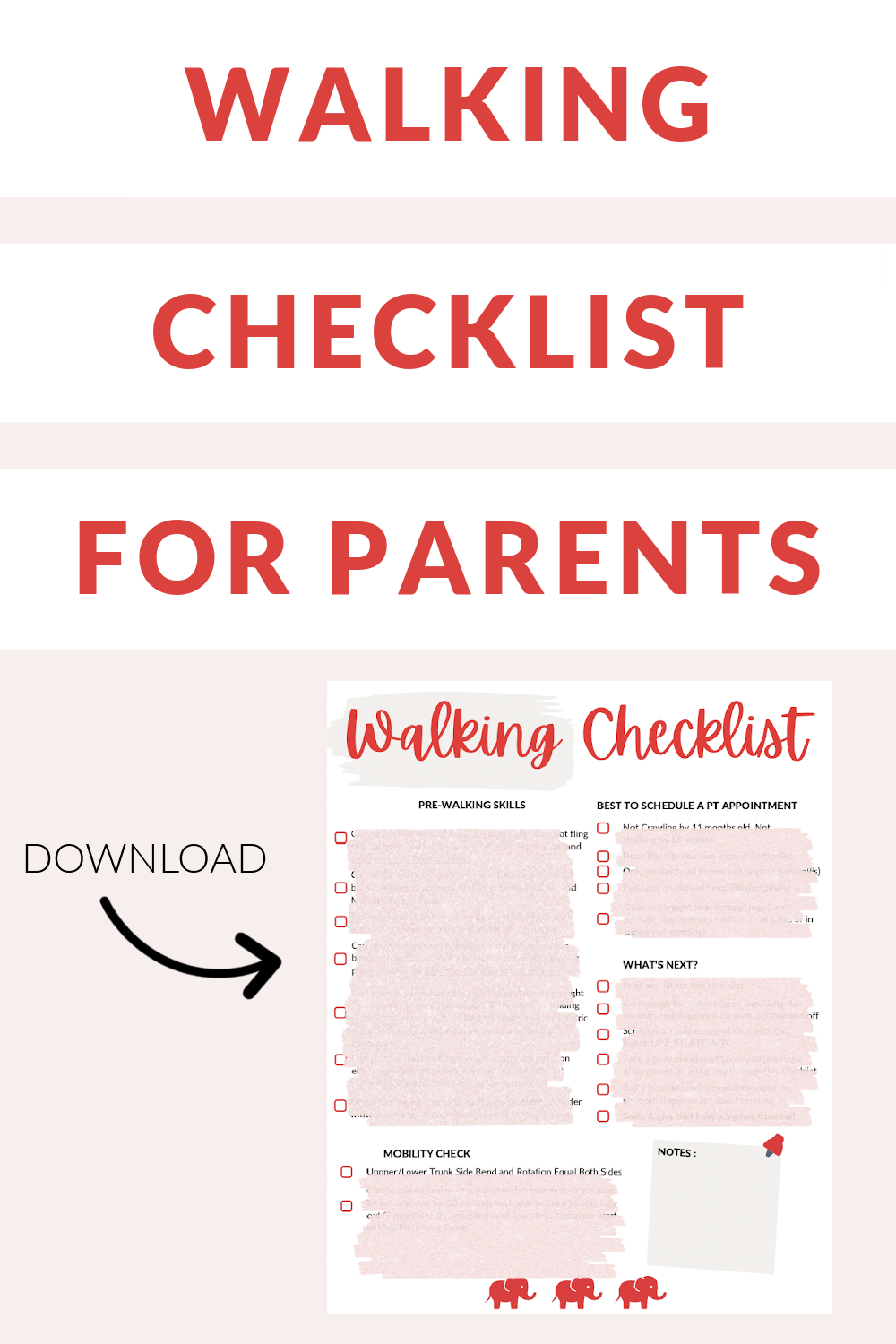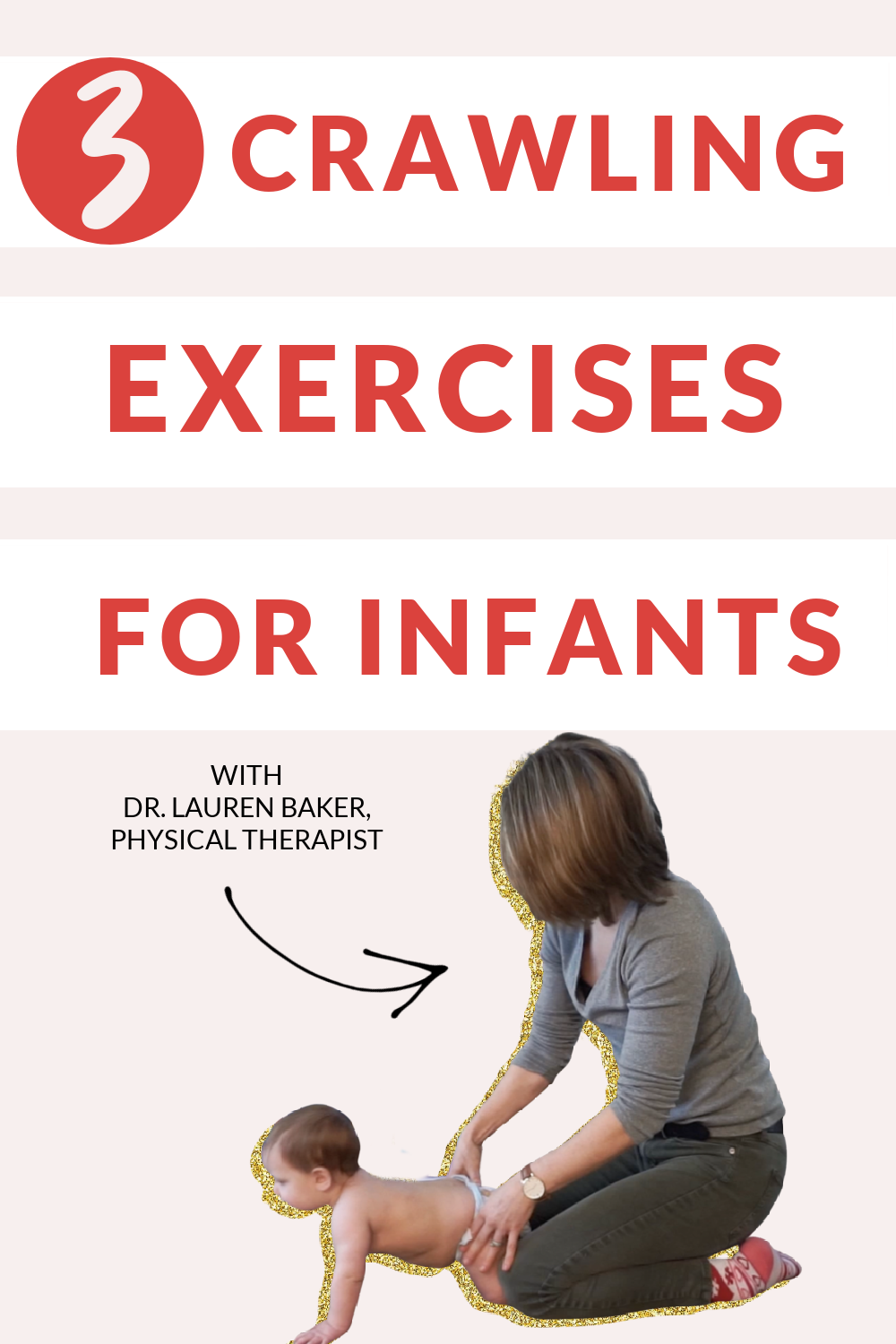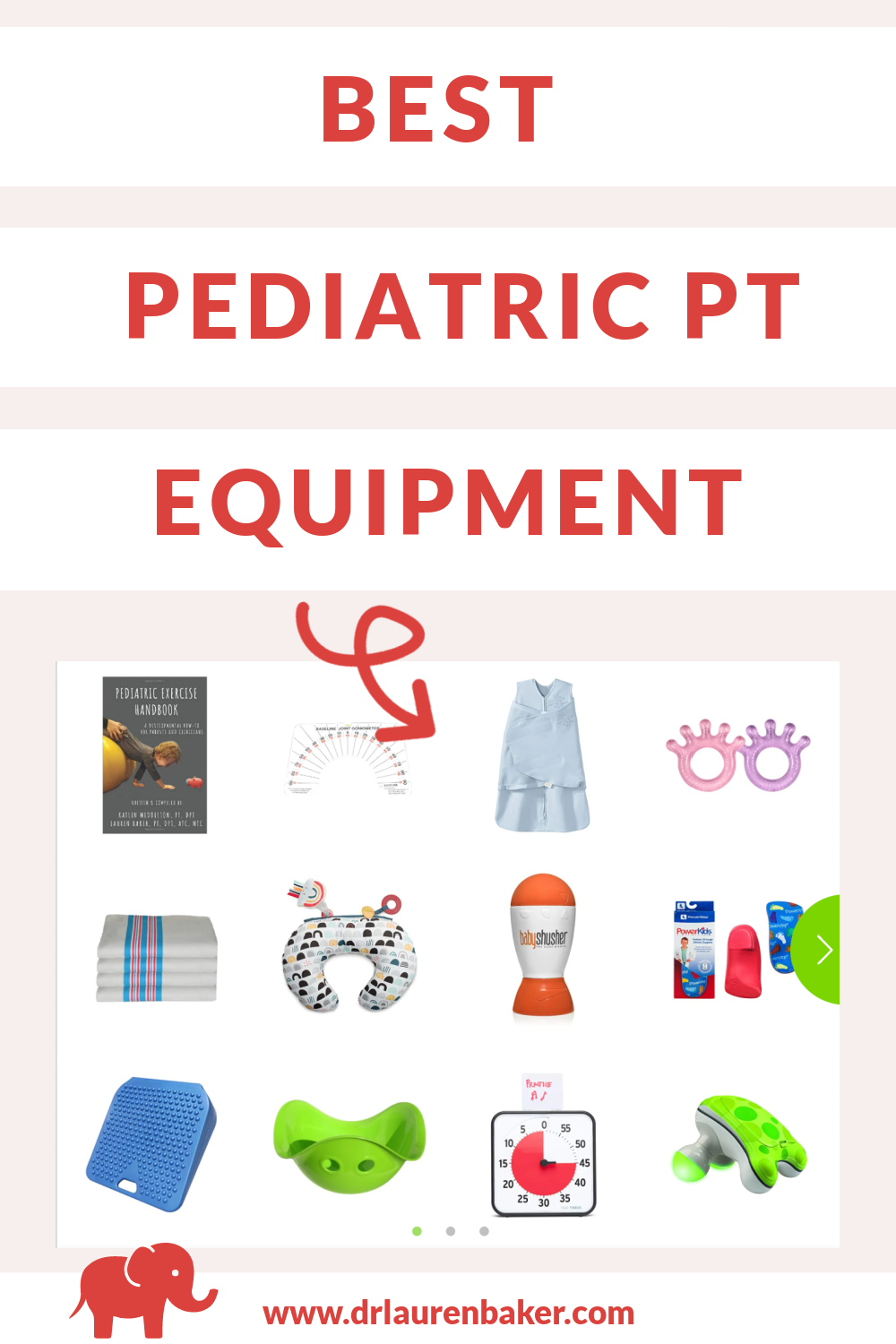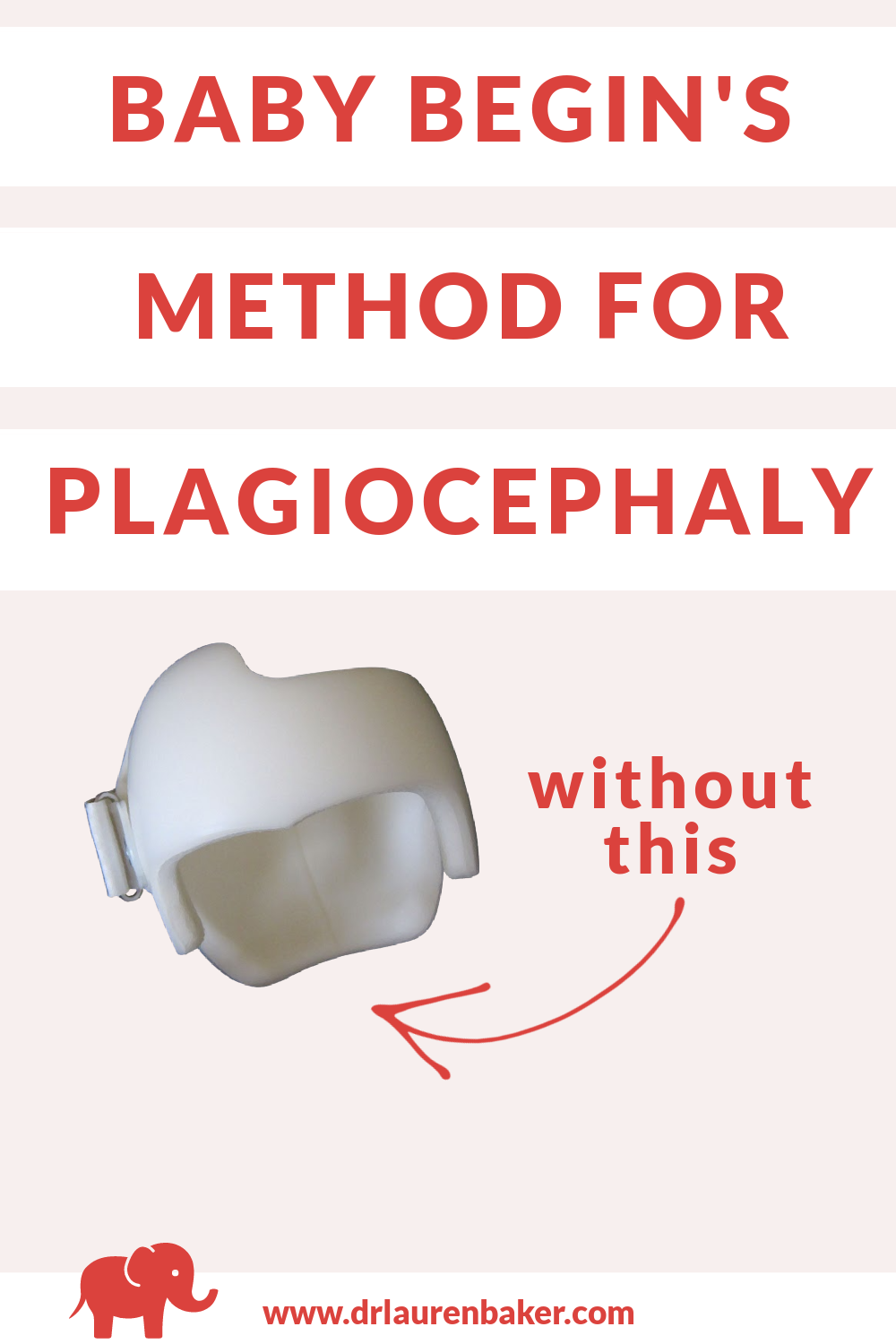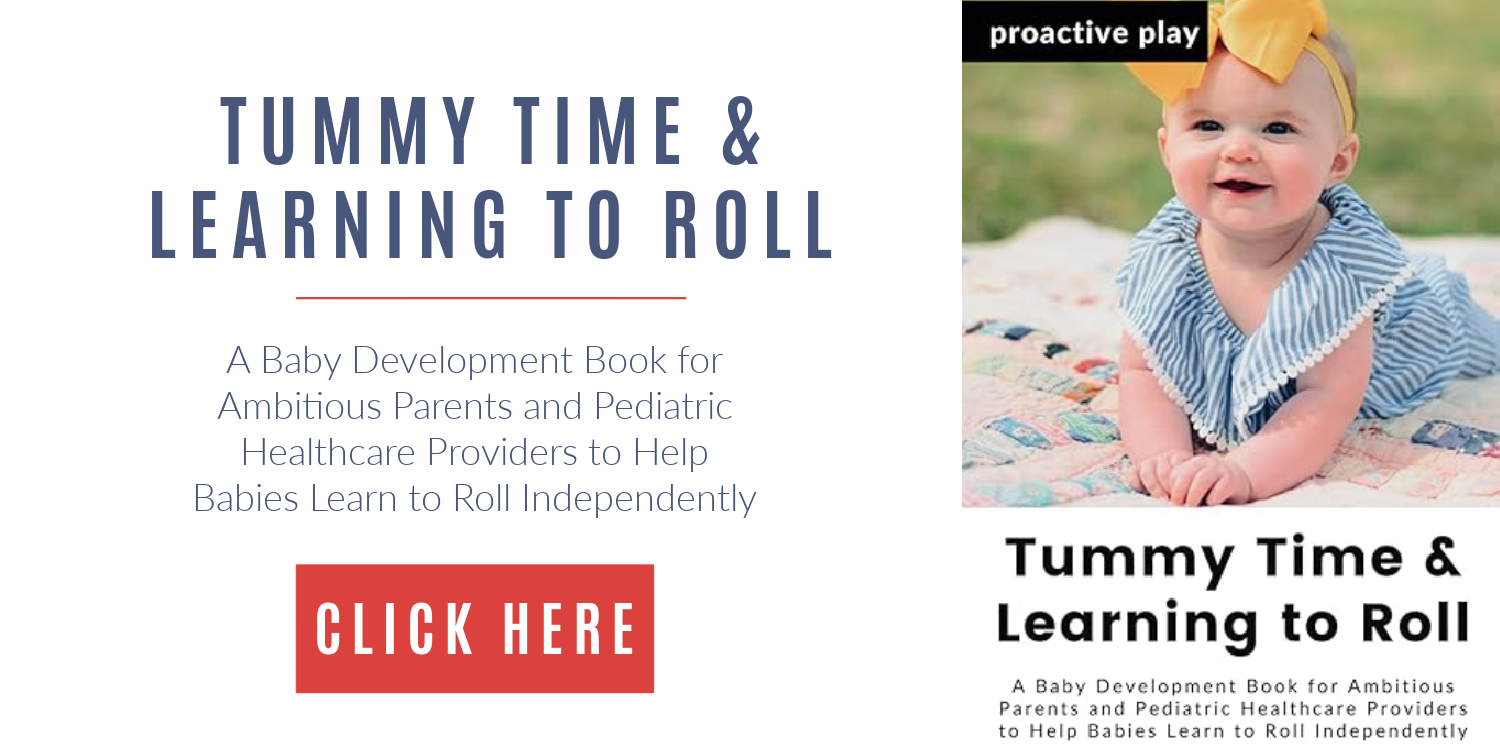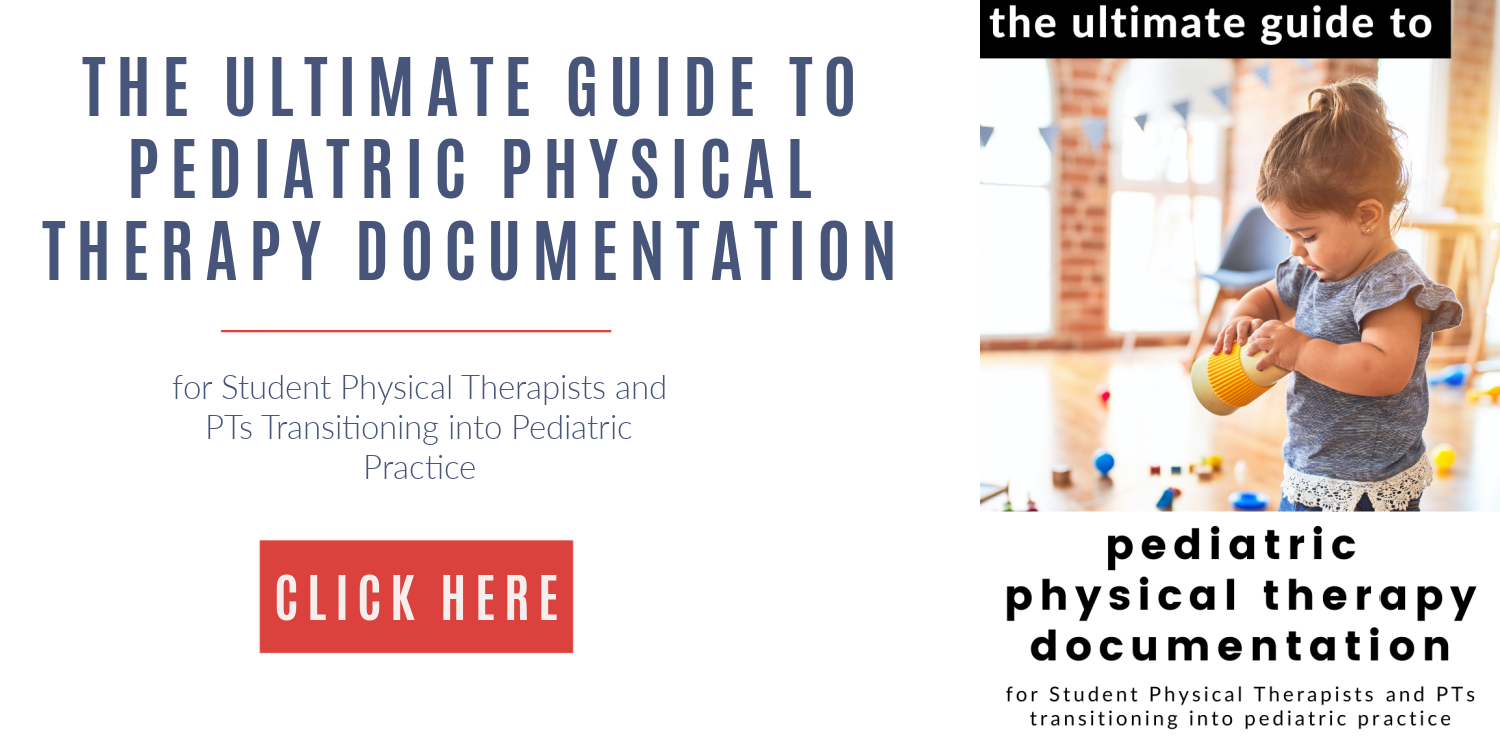6 Warning Signs of Torticollis And What To Do If It Returns
Torticollis can resurface as a baby grows from an infant to pre-school age, due to the muscles growing faster than the bones. This blog post will cover torticollis warning signs from birth to 3 years old. The blog post is by Dr. Lauren Baker, PT, DPT, ATC, MTC a pediatric in home physical therapist in Boise, ID
Early treatment for Torticollis is necessary to decrease asymmetrical movement (one side moves different than the other, or better than the other) and in order to reach gross motor milestones, avoid complications such as positional plagiocephaly (flat head), and improve gross motor skills, which are essential to academic skills such as reading, writing, and coordination.
Torticollis can resurface as a child gets older, even after Physical Therapy direct services (1:1 with a child) have been stopped due to achievement of goals. It’s important for families to know the warning signs of a reoccurrence of torticollis. These warning signs of asymmetrical movement patterns can also be used as a guide to know when to call your PT if a child was seen for delayed milestones, tightness, or other concerns.
What is Torticollis?
Plagiocephaly is a medical diagnosis that describes a flattening of the skull of infants. There are three main types of plagiocephaly: plagiocephaly, brachiocephaly, and scaphocephaly.
Plagiocephaly is a flattening on one side of the head in the back, which became more common after the introduction of the back to sleep campaign (which has decreased infant SIDS, thank goodness) but unintentionally has increased skull flattening. Data tells us that 46% of babies will have a deformation of the skull at some point in their infant lives.
Brachiocephaly is a flattening of both sides of the back of the head resulting in an increased width of the skull. Scaphocephaly is least common with a long, narrow head shape.
Plagiocephaly is often associated with a diagnosis of torticollis (head tilting and limitations in neck rotation), the baby is often rotated toward the side that is flattened and limited in the opposite direction.
The American Physical Therapy Association recommends that healthcare providers and family members screen children for head/neck tilting and preference for one side rotation of the head/neck within 2 days of birth.
Physical Therapy evaluation and treatment are recommended for infants 2 weeks and older. Torticollis has optimal results when a child receives Physical Therapy prior to 2 months of age; however, can be treated at any age. Physical Therapy average treatment is 1.5 months at up to 2 months and up to 6+ months after six months of age.
Can Torticollis be associated with Plagiocephaly?
Yes. Plagiocephaly, or flattening of the skull (usually one side of the back of the skull), is associated with both Torticollis and inutero constraint or positioning. The first warning sign of torticollis is usually a head tilt or rotation preference (rotation to the right is most common in infants). When a child spends a majority of their time in rotation, the side they prefer is at higher risk of flattening due to the pressure of the mattress/ground on the head.
It is important to eliminate any head/neck rotation preference through Pediatric Physical Therapy consultations, direct service, Chiropractic care, or a combination of both services. Plagiocephaly is easier to treat conservatively earlier, specifically before the age of 3 months. After the age of 5-6 months, or a child begins to roll, if the plagiocephaly measures in the moderate to severe range, a helmet (cranial orthosis) is typically recommended.
Physical Therapy is still recommended when a child is referred for a helmet (cranial orthosis) due to higher success rates with combined therapy and the influence of the muscular pull on the bones/joints that can decrease the effectiveness of the helmet if not completed in combination.
Can Torticollis come back after my child has been discharged from Physical Therapy?
Torticollis is a full body musculoskeletal condition, which means that the neck, trunk, and pelvis are all connected and therefore all involved. A Physical Therapy treatment and plan of care should incorporate flexibility and mobility exercises or stretches to the whole body and not just the head/neck.
Without this, the head tilt or rotation preference may return quickly after discharge of Physical Therapy. If this occurs, request additional upper and lower trunk and pelvis evaluation in the following directions: upper trunk rotation to right and left, upper trunk side bend to right and left, lower trunk rotation to right and left, lower trunk side bend to right and left. If any direction is moderately to significantly limited, further treatment is recommended.
A highly effective form of full body torticollis treatment is called Total Motion Release (TMR). Dr. Lauren Baker, PT, DPT, ATC, MTC is level 1 TMR trained and can refer to other practitioners in your area if you are not in Idaho. She can additionally help screen your child online via an online parent consultation, which you can book here.
What if my baby has been discharged but not yet crawling?
For babies with a diagnosis of torticollis, I prefer to keep children on my caseload until they are progressing toward all fours (hands and knees) crawling. The reason for this, is that there are significant alternative crawling patterns that can present in a child with a history of torticollis.
If a child struggles with being on all fours (hands and knees) and is not yet rocking on all fours (the best precursor skill to crawling), there may still be significant trunk or pelvis limitations that are contributing.
Crawling is such an important gross motor skills because it sets a child up by strengthening their hips for walking, strengthening their hands for handwriting, alternate hand/leg coordination for reading and writing, and primitive reflex integration (SNTR specifically) which is important in copying words down from the board.
I find, as a Physical Therapist, it is essential to ensure that my babies are able to progress to this stage without complications as well as educate my mamas on what to look for if there is any gaps in service (due to no current concerns, scheduling conflicts, or budget concerns).
What should I look out for?
Asymmetrical Crawling
Army Crawling
After 4-6 weeks, army crawling should naturally progress to rocking back and forth on all fours. If a child is still army crawling (belly crawling) after 4-6 weeks, there could be some tightness or limitations in the upper or lower trunk or pelvis (or all three).
Army crawling is an example of sagittal plane movement, which is the same as moving the right and left sides of your body. It is an easier movement pattern than the front plane (moving side to side) or the transverse plane (rotating your trunk to the right or left).
Army crawling is a great precursor to hands and knees crawling, but it is not ideal for long term strengthening for hands, shoulders, elbows, hips, or progressing toward academic skills such as reading, writing, or copying down from the board.
Whenever possible, it is ideal to encourage hands and knees crawling with both hands on the ground, extended elbows, and both knees on the ground. If a child is not crawling on hands and knees by 11 months, direct Pediatric Physical Therapy services are recommended.
Hitch Crawl
A hitch crawl is a combination of all fours (hands and knees) but instead of both knees on the ground, one knee is off the ground and the foot is on the ground instead.
This position is more similiar and closer to hands and knees crawling, but is not quite there. What it typically means is that one hip or trunk is tighter, which is resulting in a compensation mechanism. When one foot is on the ground, that same side of the trunk is in a side bend (their shoulder is closer to their hip on that side), which could indicate that side of the trunk is tighter.
Additionally, the side of the foot that is on the ground is pulling both with the arm on that side, as well as the foot on that side. The mechanics of this movement are far different from pushing through the knees into the ground and shifting weight from side to side. It also uses the same side body parts (the arm of the foot on the ground pulls as does the foot on the ground) instead of the right arm and left leg working in conjunction and vice versa for the left arm and right leg.
A hitch crawl is often indicative of a combination of trunk/pelvis tightness and/or core/upper trunk weakness. The hitch crawl as the sole way of crawling is not ideal, and Pediatric Physical Therapy is recommended to enhance progress toward full hands and knees crawling as well as to decrease any future complications due to not having the gross motor experience of contralateral body movements (right hand/left leg), both knees on the ground for hip strengthening (decreases risk of falls or difficulty with stairs), and improved coordination (due to weight shifting instead of one sided pulling common with hitch crawl).
Booty Scooting
If I’m being honest, the booty scoot is my least favorite of the bunch. I will take a stubborn army crawler or a hitch crawl over a booty scoot any day of the week. That being said, if your child’s only form of movement is a booty scoot, don’t be scared — just know that it will likely take longer to transition to all fours crawling than the other asymmetrical crawling types.
The biggest reason that kiddos choose to booty scoot over other forms of crawling is that they do not like to be in tummy time or in supported all fours. If the kiddo hates tummy time and has not been able to learn how to tolerate being on their belly for up to 60 minutes per day, they have a higher risk of learning the booty scoot.A child who did not like rolling from belly to back or back to belly may also progress to booty scooting because rolling requires trunk rotation and moving the upper half of the trunk on a stabilized lower half of the trunk.
Booty scooting is also typical of kiddos with significant trunk rotation limitations in both the upper and lower trunks. Booty scooting is another sagittal plane movement (like walking or moving the right and left sides of your body, which is the easier plane). The difficulty with booty scooting is that you need trunk rotation in order to transition in/out of sitting, from lying on your back to sitting, and in order to have good hip strength.Booty scooting is a pulling motion, where a child uses both hands on the floor to pull their bottom forward. They often like this motion because they can do it fast, they are upright and can see their surroundings, and they simply prefer sitting to all other positions.
Booty scooting is not ideal because it does not allow a child to increase their core strength (being on all fours is a much better core strengthening position), push through the palms of their hand into the ground (strengthening their inner hand muscles for hand writing), coordinate their alternating sides of the body together (which is the same motor plan as reading and writing), and does not all for hip strengthening (which is needed for progression to walking and decreasing difficulty with stairs, running, or jumping).
If a child is showing signs of consistent asymmetrical crawling in hitch crawling or booty scooting and/or has been army crawling for greater than 6 weeks without progression to hands/knees rocking on all fours, please call your Pediatric Physical Therapist for exercises or additional appointments. If your child has not yet seen a Pediatric Physical Therapist, it is ideal to be proactive and call on your child’s behalf in order to obtain optimal movement strategies for your child.
Difficulty with one direction of side sit
Side Sitting is one of the best types of sitting for children 7 months and older. It is a great core-strengthening position, functional to progress to getting from sitting to crawling, and helps improve both trunk rotation and crossing midline while playing.
Sometimes, one hip is tighter than the other or one side of the trunk is tighter or weaker than the other, which can influence which side sit is more comfortable for a child. Ideally, while a child may prefer one direction to use for transfers, a parent will want to make sure the child practices both directions equally during strategic play times (at least 20 minutes/day).
If a child with a history of torticollis, shows significant preference to only one side of side sit and/or they do not tolerate one direction when placed in a side sitting position, that is a sign of hip, pelvic, or trunk tightness that if not resolved with previously taught stretches, would benefit from a consultation from the child’s previous Pediatric Physical Therapist or consultation with a new Peds PT.
For examples of side sitting and modifications, please watch this video.
Pulling to Stand with only one leg
When pulling to stand, a child will lead with one leg in a half kneel “will you marry. me,” pose. At the beginning, this pose will look quite messy and they may need some assistance bringing their knee closer to the surface they are pulling up on. Sometimes, babies will even try to pull themselves up solely by their arms and use the tops of their feet, which is normal at first, but looks quite icky to most of us!
As a baby continues to pull to stand, they should progress to using the half kneeling “will you marry me” pose, with assistance or independently. A child will likely have a preferred side, but a torticollis recurrence warning sign would be if a child only used one leg forward and when prompted (you put the opposite leg forward) they collapse or aren’t able to push through it to stand.
This would be indicative of weakness in the hip, pelvis, or lateral trunk (or all three). A family can choose to practice this position by holding it statically while playing on a higher surface, by going to both knees on the ground in tall kneeling (which strengthens both hips at the same time and is less strenuous on the trunk), or by encouraging the child to pull to stand with the non-preferred leg leading.
If a family notices that progress is slow, or a child refuses to push through the non-preferred limb, or collapses when being placed in the half-kneeling “will you marry me” pose, a Pediatric Physical Therapy consultation or evaluation may be beneficial.
Cruising only to one side
If a child is only cruising to one side after practicing cruising for 4 weeks, then there may be core, pelvic, or hip strength difficulties that are limiting that child. Cruising requires more lateral trunk and hip muscular strength than sitting does, so a child with an asymmetrical crawl or a history of torticollis may be experiencing a recurrence of symptoms that are limiting their progress in this skill.
Core strength to keep a child upright, while then shifting their weight to one hip/side in order to lift the other leg off the ground and then place it, followed by shifting the weight onto that new limb, and then doing it all over again, is actually a fairly complex process! For kiddos who have hip or core tightness, they may try to avoid any unnecessary effort by simply avoiding the difficult side (this isn’t ideal, of course!).
A family who practices cruising to the non-preferred side but is struggling to motivate the child or they just plop to their bottom instead of attempting to cruise to that side, may benefit from a Pediatric Physical Therapy consultation or evaluation.
Increased falls while walking after walking independently for 6 months
Kiddos fall a lot as they learn to walk. Falling in itself is not a bad thing, in fact, families can help their kiddos learn to walk simply by cheering when they fall down instead of showing fear. Kiddos naturally fall to their bottom and get back up and try again often falling over 17 times per hour, which is normal.
After six months, though, a child should be able to walk independently with much less falling. If you feel as though your child is falling more frequently than their peers, it may be due to a core/hip strength or mobility concern that is popping back up. Falling frequently does increase the risk of accidental self-injury but alone is a little bit of a tough area to differentiate between what is any okay number of falls (ages 1-4 years, frequent falls after age four is always a concern) and what is an age appropriate amount when “we’re learning about this gravity thing?”
The rule of thumb I give parents is that if your intuition tells you that your child is falling more than their peers, they likely are and could benefit from Physical Therapy. If your child is both falling more than their peers AND has one or more of the other signs and symptoms of asymmetrical movement or recurrence of torticollis, then you can confidently reach out for additional Physical Therapy support. The biggest one I’d see combined with falling is difficulty ascending/descending stairs. If a child is struggling with two areas, seeing a Pediatric Physical Therapist is recommended.
Difficulty with Climbing or Descending stairs
Stairs are super difficult. Let us first talk about at what ages should children be able to do stairs, because there is a systematic way of progressing to walking up/down stairs on your own.
18-22 months: walk up/down stairs while holding your hand and/or a railing/wall
24 months: walk up/down two steps independently while holding onto a wall/railing (not your hand)
30 months: walk up stairs using one foot on each step (R foot then L foot then R foot, with one foot on each step) with/without holding onto the wall/railing
Typically, if a child has difficulty (weakness or difficulty with balance) with one limb they are going to go up the stairs with the opposite limb with two feet at a time (R is stronger, R goes up the stair then L meets it on the stair, R goes up the next stair). If a child struggles with either balance or strength or both, they may insist on holding a parents hand, which after 24 months of age is not ideal. To help a child progress to independent stair climbing, a parent can support the child at the hips instead of holding their hand, walk behind them as the child goes up the stairs, and walk facing them but below them when going down the stairs.
When descending stairs, if a child has weakness or difficulty with balance, we often see them ask to be carried down the stairs, scoot on their bottom down the stairs, or refuse to walk down the stairs by becoming upset because it is too difficult. Walking down the stairs, children typically lead with the leg that is weakest. For example, if the R leg is strong and the L leg is weak, the child with go up the stairs with the R, but go down the stairs leading with the L (in both directions, the R leg does all the work).
If a child refuses to switch limbs or uses only one limb when prompted by an adult when descending stairs, even when the adult switches sides (uses the railing going down and uses the wall on the opposite side going down), there is likely an imbalance in one limb/side of the trunk, which could benefit from PT.
How can I have my baby or child work with Dr. Lauren?
If you would like Dr. Baker to come to your home to evaluate your baby (2 weeks+) or toddler you can schedule an evaluation online. Evaluations are 60 minutes in person in the Treasure Valley and Boise area. For pricing considerations please visit our pricing page. If your baby/toddler is not in Idaho, you may schedule an online parent consultation, where Dr. Baker, DPT, will answer any questions you may have and/or screen your child if appropriate.
10+ Pediatric Physical Therapy Intake Form Examples and Templates
10+ Pediatric Physical Therapy Intake Forms and Examples including: Online Parent Consultation Consent Form, Online Parent Consultation Intake Form Template, Online Parent Consultation Documentation Template, Pediatric PT Covid-19 Waiver Example, Good Faith Estimate Example, Informed Consent for Pediatric PT Example, Example Medicaid Release Form, Pediatric PT Intake Form Template, Pediatric PT Practice Policies Example, Pediatric PT Privacy Policies (HIPPA) Example, Release of Information Form Template, Youtube Video Release Template, Pediatric PT Evaluation Template, Pediatric PT Progress Report Template, and SOAP Note Template
Hi, I’m Dr. Lauren Baker, PT, DPT, ATC, MTC, and I run a cash based mobile pediatric physical therapy business. I’m literally obsessed with this style of therapy, having a flexible schedule, and all the things that come along with not having the barriers that a traditional insurance based clinic has.
That being said, starting out was kind of hard at first, mostly because I wasn’t quite sure what I was doing — but also because there was SO MUCH to create: intake forms, consent forms, and documentation templates.
After a year+ in business, I feel like I have it mostly under control from an administration standpoint and thought I would share my intake, consent, and documentation forms with other Pediatric PTs who want to move into the cash based mobile peds PT business too.
You see, some people might think that by sharing these forms I’d be creating more competition for myself — but I see the opposite. I see a world where babes are treated in the comfort of their own home with therapists who are able to treat them compassionately and with a high level of energy and support because they’re not burnt out.
So to me, that means we’ve got to convince more peds PTs to take the plunge (& the risk) — which results in making the whole process less scary.
This is my goal in sharing these forms. I hope they help.
Disclaimer: I created these forms myself as well as from some standard language provided by Simple Practice. As of 2022 they have not been reviewed by a lawyer. Use them at your own risk and I highly recommend consulting with a lawyer prior to using them.
Here are all of the forms you can download and use for free:
Online Parent Consultation Consent Form
Online Parent Consultation Intake Form
Online Parent Consultation Documentation Template
Covid-19 Waiver
Good Faith Estimate
Informed Consent for Pediatric PT
Medicaid Release Form
Pediatric PT Intake Form
Pediatric PT Practice Policies
Pediatric PT Privacy Policies (HIPPA)
Release of Information
Youtube Video Release
Pediatric PT Evaluation Template
Pediatric PT Progress Report Template
SOAP Note Template
Using Pediatric PT Intake and Documentation Forms
For full disclosure, these pdf forms are in the format directly downloaded from my all in one system (EMR + online scheduler + credit card payment). I use Simple Practice, which I absolutely love because it is an all in one system that makes sending, e-signing, scheduling, and getting paid something I honestly barely even spend brainpower on.
You can use these forms to create your own in Simple Practice and if you are looking for an all in one system you can sign up for Simple Practice here. You’ll receive $100 off & I will also receive $100 if you sign up using that link.
I currently utilize the $99/month option but you could get started using the $69/month option. The one thing I do dislike about Simple Practice is that they included the google calendar sync in their 99$/mo pricing tier, which I absolutely need. Otherwise, I would still be in the 69/mo category. I would recommend others start with 69/month unless they absolutely need google sync.
Simple Practice does have its own app so if you have fewer patients or are okay with carrying over your appointments to your google calendar manually, it might be worth it to save $30/mo. You can do everything I do with the $69/mo plan.
are you a pediatric PT with a mobile peds business?
If you are a pediatric PT who operates a cash based or mobile business and are interested in being interviewed on my youtube channel, please reach out here. I love sharing mobile and cash based peds PT businesses.
Crawling Exercises For Your Baby | Reaching On All Fours To Build Baby Arm Strength
Before you can crawl, you need to be able to reach for toys in all fours. In this video, you'll learn ways to help your baby learn to crawl and a few crawling exercises for your baby to build arm strength and progress to crawling.
This post contains affiliate links, please see my disclaimer for more information.
Lauren is the owner of Dr. Lauren Baker In Home Pediatric Physical Therapy and provides paid 60-minute online parent consultations for individuals with additional questions internationally. For scheduling please click here.
This video will teach you:
How to support your baby in all fours
How to help them reach for a toy to progress toward crawling
What toys work well for this exercise
find what you’re looking for
0:28 what exercise we’re going to learn today
0:40 why reaching on all fours is important to learn before crawling
1:24 exercise #1: quadruped reaching with wooden activity cube toy
1:50 breakdown of what I am doing during the quadruped reaching exercise
3:45 what to do when a kiddo is struggling in all fours
4:10 exercise #2 reaching with small toys on all fours
6:27 how to work with dr. Lauren Baker, PT, DPT, ATC, MTC
transcription coming soon
subscribe to dr. lauren baker on youtube, so you know where you found this video & you can find it again (in case you need it for yourself or to share it with a friend who might benefit from it!).
Leave a comment if you have any questions, it’s my absolute favorite thing to share resources, connect you with what you’re looking for, and give general education.
I have a firm philosophy that everyone deserves a physical therapist best friend & if you don’t have one yet — we can be online besties!
links and additional information
LINKS IN VIDEO
Wooden Activity Center toy: https://amzn.to/3I5q1bc
🍼 Best Toys for Babies - https://kit.co/drlaurenbaker/best-toy...
Get a gorgeous NC landscape print like the one behind me - https://rachelcarterimages.com/buy-pr...
Macramé feather hanging - https://botanicalknotsstudio.com/
HAVE MORE QUESTIONS? book a 60 minute online consultation with dr. lauren baker, physical therapist
MY BOOKS ON AMAZON:
📚New in 2021 - The Ultimate Guide To Pediatric Physical Therapy Documentation
📚Amazon Best Selling Pediatric Exercise Handbook
📚The Boy and The Boomerang Children’s Book
for parents
PEDIATRIC ONLINE COURSES:
Get Your Munchkin Moving Gross Motor Online Course 6-15 months - $5 OFF with code: drlaurenbaker
for active women (moms & aunts!)
FITNESS:
💪 Free 30 minute home workouts
👋 Workout with me in The Girl Squad
FITNESS PODCAST:
🎙Decrease your resistance to fitness the podcast
MY FAVORITE THINGS:
🏋️♀️ Shop my home gym equipment
⚡ Must have injury prevention equipment
for physical therapists / student physical therapists
💻 Start Your Own Cash Based Mobile Pediatric Business with Simple Practice (EMR, Scheduling, Payment)
🧭 Learn How To Create An Online Course & Host It For Free For Life ($50/mo savings)
other fun things
LEARN WITH ME:
📘Read lots & lots of books using a kindle unlimited subscription here
CONNECT OFF YOUTUBE:
🖱️ My pediatric website / blog
👩⚕️Find a PT
DISCLAIMERS: The information provided on this site is intended for your general knowledge only and is not a substitute for professional medical advice or treatment for specific medical conditions. You should not use this information to diagnose or treat a health problem or disease without consulting with a qualified healthcare provider. Please consult your healthcare provider with any questions or concerns you may have regarding your condition. By watching this video you release Dr. Lauren Baker, PT, DPT, ATC, MTC and all related parties from any and all liability. *As an Amazon Associate I earn from qualifying purchases. The links listed above are 99% affiliate links (amazon or other programs), which means I earn from qualifying purchases at no extra cost to you.
Music from intro courtesy of: Campfire by Scandinavianz https://soundcloud.com/scandinavianz Creative Commons — Attribution 3.0 Unported — CC BY 3.0 Free Download / Stream: https://bit.ly/_campfire Music promoted by Audio Library https://youtu.be/9Rfykh-YzCc
5 Tips and Activities For Children With Visual Impairments
This video will teach you:
how to work with or support kiddos with visual impairments
This post contains affiliate links, please see my disclaimer for more information.
Lauren is the owner of Dr. Lauren Baker In Home Pediatric Physical Therapy and provides paid 60-minute online parent consultations for individuals with additional questions internationally. For scheduling please click here.
find what you’re looking for
0:07 #1 don’t put hands in substances without a warning
1:03 tactile defensiveness
1:39 #2 use your voice to prepare the child for who you are and what you’re going to do
3:26 #3 hand under hand technique vs hand over hand method and which to use
4:38 example of using hand under hand technique with reaching in independent sitting with/without visual impairment
4:42 #4 use different sensory experiences
5:09 how and where to support a child using the hand under hand method for seated reaching activities
5:51 #5 give enough response time 30-60 seconds to allow the child to initiate movement on their own
8:00 example of reaching task with dual sensory experience (ball + aquarium toy)
9:12 how to assist with grasp and release with a child with high tone
9:49 summary of 5 tips for working with children with visual impairments
LINKS IN VIDEO:
The Best Sensory Toys: https://kit.co/drlaurenbaker/best-ped...
Aquarium Toy (Similar): https://amzn.to/336uieX
Ideas for types of sensory: vestibular (swings or bouncing), tactile (sand/wet/slimy/lotion/dirty/bananas/avocados, bumpy structures, sensory books), auditory (songs, toys that make noise, banging things together), visual (some children can see aspects of color such as shiny or yellows).
transcription coming soon
subscribe to dr. lauren baker on youtube, so you know where you found this video & you can find it again (in case you need it for yourself or to share it with a friend who might benefit from it!).
Leave a comment if you have any questions, it’s my absolute favorite thing to share resources, connect you with what you’re looking for, and give general education.
I have a firm philosophy that everyone deserves a physical therapist best friend & if you don’t have one yet — we can be online besties!
links and additional information
HAVE MORE QUESTIONS? book a 60 minute online consultation with dr. lauren baker, physical therapist
MY BOOKS ON AMAZON:
📚New in 2021 - The Ultimate Guide To Pediatric Physical Therapy Documentation
📚Amazon Best Selling Pediatric Exercise Handbook
📚The Boy and The Boomerang Children’s Book
for parents
PEDIATRIC ONLINE COURSES:
Get Your Munchkin Moving Gross Motor Online Course 6-15 months - $5 OFF with code: drlaurenbaker
for active women (moms & aunts!)
FITNESS:
💪 Free 30 minute home workouts
👋 Workout with me in The Girl Squad
FITNESS PODCAST:
🎙Decrease your resistance to fitness the podcast
MY FAVORITE THINGS:
🏋️♀️ Shop my home gym equipment
⚡ Must have injury prevention equipment
for physical therapists / student physical therapists
💻 Start Your Own Cash Based Mobile Pediatric Business with Simple Practice (EMR, Scheduling, Payment)
🧭 Learn How To Create An Online Course & Host It For Free For Life ($50/mo savings)
other fun things
LEARN WITH ME:
📘Read lots & lots of books using a kindle unlimited subscription here
CONNECT OFF YOUTUBE:
🖱️ My pediatric website / blog
👩⚕️Find a PT
DISCLAIMERS: The information provided on this site is intended for your general knowledge only and is not a substitute for professional medical advice or treatment for specific medical conditions. You should not use this information to diagnose or treat a health problem or disease without consulting with a qualified healthcare provider. Please consult your healthcare provider with any questions or concerns you may have regarding your condition. By watching this video you release Dr. Lauren Baker, PT, DPT, ATC, MTC and all related parties from any and all liability. *As an Amazon Associate I earn from qualifying purchases. The links listed above are 99% affiliate links (amazon or other programs), which means I earn from qualifying purchases at no extra cost to you.
Music from intro courtesy of: Campfire by Scandinavianz https://soundcloud.com/scandinavianz Creative Commons — Attribution 3.0 Unported — CC BY 3.0 Free Download / Stream: https://bit.ly/_campfire Music promoted by Audio Library https://youtu.be/9Rfykh-YzCc
3 Crawling Exercises For Infants
Here are three crawling exercises for infants or exercises to get your baby crawling.
This post contains affiliate links, please see my disclaimer for more information.
Lauren is the owner of Dr. Lauren Baker In Home Pediatric Physical Therapy and provides paid 60-minute online parent consultations for individuals with additional questions internationally. For scheduling please click here.
This video will teach you:
Three Exercises to help your baby crawl
Why crawling is absolutely necessary and should not be skipped
What a Pediatric PT can do if your baby needs extra help
find what you’re looking for
0:00 introduction
3:11 exercise #1 quadruped rocking
4:15 exercise #2 quadruped reaching
5:36 exercise #3 assisted crawling
7:07 what pediatric physical therapy can do
7:52 crawling playlist - https://www.youtube.com/playlist?list...
transcription coming soon
subscribe to dr. lauren baker on youtube, so you know where you found this video & you can find it again (in case you need it for yourself or to share it with a friend who might benefit from it!).
Leave a comment if you have any questions, it’s my absolute favorite thing to share resources, connect you with what you’re looking for, and give general education.
I have a firm philosophy that everyone deserves a physical therapist best friend & if you don’t have one yet — we can be online besties!
links and additional information
HAVE MORE QUESTIONS? book a 60 minute online consultation with dr. lauren baker, physical therapist
MY BOOKS ON AMAZON:
📚New in 2021 - The Ultimate Guide To Pediatric Physical Therapy Documentation
📚Amazon Best Selling Pediatric Exercise Handbook
📚The Boy and The Boomerang Children’s Book
for parents
PEDIATRIC ONLINE COURSES:
Get Your Munchkin Moving Gross Motor Online Course 6-15 months - $5 OFF with code: drlaurenbaker
for active women (moms & aunts!)
FITNESS:
💪 Free 30 minute home workouts
👋 Workout with me in The Girl Squad
FITNESS PODCAST:
🎙Decrease your resistance to fitness the podcast
MY FAVORITE THINGS:
🏋️♀️ Shop my home gym equipment
⚡ Must have injury prevention equipment
for physical therapists / student physical therapists
💻 Start Your Own Cash Based Mobile Pediatric Business with Simple Practice (EMR, Scheduling, Payment)
🧭 Learn How To Create An Online Course & Host It For Free For Life ($50/mo savings)
other fun things
LEARN WITH ME:
📘Read lots & lots of books using a kindle unlimited subscription here
CONNECT OFF YOUTUBE:
🖱️ My pediatric website / blog
👩⚕️Find a PT
DISCLAIMERS: The information provided on this site is intended for your general knowledge only and is not a substitute for professional medical advice or treatment for specific medical conditions. You should not use this information to diagnose or treat a health problem or disease without consulting with a qualified healthcare provider. Please consult your healthcare provider with any questions or concerns you may have regarding your condition. By watching this video you release Dr. Lauren Baker, PT, DPT, ATC, MTC and all related parties from any and all liability. *As an Amazon Associate I earn from qualifying purchases. The links listed above are 99% affiliate links (amazon or other programs), which means I earn from qualifying purchases at no extra cost to you.
Music from intro courtesy of: Campfire by Scandinavianz https://soundcloud.com/scandinavianz Creative Commons — Attribution 3.0 Unported — CC BY 3.0 Free Download / Stream: https://bit.ly/_campfire Music promoted by Audio Library https://youtu.be/9Rfykh-YzCc
Pediatric Physical Therapy Equipment and Supplies
Pediatric Physical Therapy Equipment and Supplies
This post contains affiliate links, please see my disclaimer for more information.
Lauren is the owner of Dr. Lauren Baker In Home Pediatric Physical Therapy and provides paid 60-minute online parent consultations for individuals with additional questions internationally. For scheduling please click here.
Some of my favorite pediatric physical therapy tools, toys, and supplies to build fine/gross/cognitive skills.
Top Favorites:
How To Fill Out A Claims Form For Out of Network Reimbursement
This tutorial explains how to submit for reimbursement when receiving cash based pediatric physical therapy services from an out of network provider using a humana claims form as an example.
Your provider may have different information so please refer to your specific form (superbill) for the values you need for your own reimbursement. Not all insurance plans have out of network benefits so please consult your specific insurance prior to receiving any out of network care.
This post contains affiliate links, please see my disclaimer for more information.
Lauren is the owner of Dr. Lauren Baker In Home Pediatric Physical Therapy and provides paid 60-minute online parent consultations for individuals with additional questions internationally. For scheduling please click here.
This video will teach you:
How to fill out an out of network claims form generally
How to fill out an out of network claims form for pediatric physical therapy services
What each section of a claims form means and where to put each code
What a superbill looks like and what each part means
Tips to help you receive your out of network reimbursement quicker and easier
find what you’re looking for
0:45 example superbill and explanation of parts of the form
2:21 medical vs rehab (PT) diagnosis ICD-10 codes
3:16 evaluation codes for physical therapy
3:39 place of service code explanations 11 (clinic) vs 12 (home based)
4:22 CPT code / service codes
5:12 treatment code / service code / CPT code examples for physical therapy
5:40 GP modifier on CPT codes
6:14 multiple code examples
6:52 differences in reimbursement per code
7:32 make payments to section of superbly
7:55 fill out claims form with me Humana claims form example
9:55 fill out the PT section (CPT codes, service description, POS, date of service, etc)
10:18 further explanation difference between POS 11 and 12 (clinic / home)
10:55 CPT code / service description
11:34 multiple codes per date of service example
12:24 provider information
13:44 do not miss adding this specific piece of info for provider section
15:44 tips on being organized to make sure you get payment from insurance company
LINKS IN VIDEO:
Simple Practice which autogenerates my super bills (for therapists) - https://www.simplepractice.com/?p=b2f...
Link to Humana claims form - https://docushare-web.apps.cf.humana....
Get a gorgeous NC landscape print like the one behind me - https://rachelcarterimages.com/buy-pr...
transcription coming soon
subscribe to dr. lauren baker on youtube, so you know where you found this video & you can find it again (in case you need it for yourself or to share it with a friend who might benefit from it!).
Leave a comment if you have any questions, it’s my absolute favorite thing to share resources, connect you with what you’re looking for, and give general education.
I have a firm philosophy that everyone deserves a physical therapist best friend & if you don’t have one yet — we can be online besties!
links and additional information
HAVE MORE QUESTIONS? book a 60 minute online consultation with dr. lauren baker, physical therapist
MY BOOKS ON AMAZON:
📚New in 2021 - The Ultimate Guide To Pediatric Physical Therapy Documentation
📚Amazon Best Selling Pediatric Exercise Handbook
📚The Boy and The Boomerang Children’s Book
for parents
PEDIATRIC ONLINE COURSES:
Get Your Munchkin Moving Gross Motor Online Course 6-15 months - $5 OFF with code: drlaurenbaker
for active women (moms & aunts!)
FITNESS:
💪 Free 30 minute home workouts
👋 Workout with me in The Girl Squad
FITNESS PODCAST:
🎙Decrease your resistance to fitness the podcast
MY FAVORITE THINGS:
🏋️♀️ Shop my home gym equipment
⚡ Must have injury prevention equipment
for physical therapists / student physical therapists
💻 Start Your Own Cash Based Mobile Pediatric Business with Simple Practice (EMR, Scheduling, Payment)
🧭 Learn How To Create An Online Course & Host It For Free For Life ($50/mo savings)
other fun things
LEARN WITH ME:
📘Read lots & lots of books using a kindle unlimited subscription here
CONNECT OFF YOUTUBE:
🖱️ My pediatric website / blog
👩⚕️Find a PT
DISCLAIMERS: The information provided on this site is intended for your general knowledge only and is not a substitute for professional medical advice or treatment for specific medical conditions. You should not use this information to diagnose or treat a health problem or disease without consulting with a qualified healthcare provider. Please consult your healthcare provider with any questions or concerns you may have regarding your condition. By watching this video you release Dr. Lauren Baker, PT, DPT, ATC, MTC and all related parties from any and all liability. *As an Amazon Associate I earn from qualifying purchases. The links listed above are 99% affiliate links (amazon or other programs), which means I earn from qualifying purchases at no extra cost to you.
Music from intro courtesy of: Campfire by Scandinavianz https://soundcloud.com/scandinavianz Creative Commons — Attribution 3.0 Unported — CC BY 3.0 Free Download / Stream: https://bit.ly/_campfire Music promoted by Audio Library https://youtu.be/9Rfykh-YzCc
Physical Therapist Approved Toddler+ Toys
Pediatric Physical Therapist approved toys for toddlers.
This post contains affiliate links, please see my disclaimer for more information.
Lauren is the owner of Dr. Lauren Baker In Home Pediatric Physical Therapy and provides paid 60-minute online parent consultations for individuals with additional questions internationally. For scheduling please click here.
Some of my favorite toddler toys to keep kiddos engaged and build fine/gross/cognitive skills.
Top Favorites:
Physical Therapist Approved Baby Toys
PT approved Baby Toys for building gross motor skills.
This post contains affiliate links, please see my disclaimer for more information.
Lauren is the owner of Dr. Lauren Baker In Home Pediatric Physical Therapy and provides paid 60-minute online parent consultations for individuals with additional questions internationally. For scheduling please click here.
Some of my favorite baby toys to keep kiddos engaged and build fine/gross/cognitive skills.
Top Favorites:
6 Ways To Make Pediatric Physical Therapy Documentation Quick and Easy
Pediatric Physical Therapy Documentation is very different than adult orthopedic and neurological physical therapy documentation because when you’re working with kids, the interventions you are completing are play based, functional, and take more critical analytical skills to produce documentation that is authoritative and skilled. Often in PT school, Student Physical Therapists are taught adult based Physical Therapy Documentation and left to learn Pediatric Physical Therapy Documentation on their own. Here are 6 ways to make pediatric physical therapy documentation quick and easy, along with a resource at the end that will help you enhance your Pediatric Physical Therapy Documentation skills with ease.
This post contains affiliate links, please see my disclaimer for more information.
Take notes during your pediatric physical therapy session
Taking notes is a huge time save when you’re completing pediatric physical therapy documentation. Pediatric PT sessions move really quickly and if you are not taking data in real time, it is quite easy to forget which leg lead when going up the stairs and which leg lead when going down the stairs (especially since they’re often opposite).
Taking notes ensures that you have specific data to go back to when you start your SOAP note, Evaluation, Progress Note, or Discharge. It also ensures that it’s as accurate as possible. While taking notes during sessions is helpful from a productivity stand point, it isn’t always realistic, and going off memory is difficult, time-consuming, and generally inaccurate (especially if you check out the data on witness accuracy, I cannot imagine PT accuracy is that much different a few hours after an appointment or even a day later).
When you go to write a SOAP note off of a pre-written note, there is a much higher likelihood of its accuracy, it also works as a cue for your brain to remember more details for the note like the specific exercise the child was doing, the position they were in, and what activity you did before and after the one you jot down.
Create your own shorthand abbreviations for your PT data
Taking down notes for pediatric physical therapy documentation does not have to take that much time, especially if you create your own written language for data points that you use for specific circumstances. Abbrevations used in pediatric documentation that is official such as SOAP notes typically must be either spelled out in advance ie BL (bilateral) then use BL for future sentences in the note or they must be universally recognized by the medical community.
When you write your short hand notes in a small notebook, however, you can write whatever you want down that is quick and easy as long as you know what it means. Personally, that means using abbreviations including arrows up/down for ascending/descending stairs, LLE up arrow if the left leg led while ascending stairs, or LLE down arrow if the left leg led when descending stairs. Other common abbreviations I use are: RGP (recirpocal gait pattern), STGP (step to gait pattern), sit <> st (sit to stand and stand to sit transitions), etc. There is freedom for you to create whatever abbreviations help you, including using fractions for successful trials/total trials ie 4/5 would mean that 4 times the child completed the trial successfully, but you completed it a total of 5 times; therefore the child was unsuccessful 1/5 times.
Time yourself to make pediatric physical therapy documentation quicker.
Writing pediatric physical therapy documentation notes, progress notes, evaluations, discharges, IEPs, etc can take different amount of lengths depending on the child, the circumstance, whether there are on-going legal concerns, and/or depending on the detail required by insurance companies, doctors, bosses, etc. I do find that it is extremely helpful to time myself when typing SOAP notes and other styles of notes.
I find that SOAP notes can take me anywhere from 5 to 15 minutes, depending on my level of detail and length of the session. If you’re just starting out as a PT student, it might take you 30 minutes per SOAP note and multiple hours for an evaluation. It’s important to build a time goal into your documentation skills as this is a specific skill set needed to maintain both productivity and also your sanity. If it takes you 30 minutes to write a SOAP note ever single time you see a patient, your workload will double and you will likely be very unhappy.
Using timers and the Pomodoro principle where you are writing for 25 minutes and then take a 5 minute break can increase your effectiveness and focus. Note also that if you distract yourself by googling something or checking your phone it will take you 15 more minutes to focus, during which time you could have another note written.
Understand what goes where
Learning the differences between subjective, objective, assessment, and plan data and information can be tricky in the pediatric physical therapy documentation world. Ideally, subjective information is information gathered prior to the start of the appointment and history of what happened since the previous visit, usually given via a parent or teacher report. It can also include upcoming concerns, dates, or information.
Objective information is data-driven and activity-focused, it includes specific interventions done in the PT session or evaluation and the data collected. In pediatrics it is a little harder to tease out the objective and assessment data from each other. If you need additional resources including prompts for sentence structure and questions to help you figure out what is objective and what is assessment, the book The Ultimate Guide to Pediatric Physical Therapy Documentation will be a helpful resource for you.
Create key phrases to use for your pediatric documentation
Having specific key phrases that you go back to in order to get your point across and make sure that you are not missing anything can be really helpful to systemize in your brain. Examples include a signs and symptoms (sx) statement in your assessment section to note pediatric physical therapy impairments in the documentation. For example, a child who is struggling with crawling and has a medical diagnosis of developmental delay may have a signs and sx statement that looks like this, “Johnny presents with signs and sx consistent with a medical diagnosis of developmental delay and gross motor concerns that are resulting in delays in crawling including decreased strength in core, hip and shoulder girdle muscles as well as decreased motor planning necessary to attain independent mobility.”
Other examples of key phrases include, “Skilled PT is necessary in order to xxx,” at the end of the assessment paragraph of each SOAP note or a specific phrase in the Plan section that includes, “continue with Plan of Care (POC).”
Buy The Ultimate Guide to Pediatric Physical Therapy Documentation for Student Physical Therapists and PTs Transitioning into Pediatric Practice book.
There are so many specific nuances of documentation in the pediatric world that are required in order to have your interventions sound skilled and authoritative. It is important that documentation shows the expertise that the Pediatric Physical Therapist brings to their interventions and differentiates the intervention from play based activities that the parent is able to do on their own.
If you’d like more information on how to master Pediatric Physical Therapy Documentation, please check out The Ultimate Guide to Pediatric Physical Therapy Documentation for Student Physical Therapists and PTs Transitioning into Pediatric Practice on amazon.
You’ll Learn How To Document:
Pediatric Physical Therapy Evaluations
Progress Notes, Treatment Sessions, and Discharges
In both the school and medical model settings (outpatient and hospital based)
It’ll include examples of:
Understanding PT documentation
Expressing interventions as skilled
Differentiating between objective and assessment data
Simple sentence structures and examples
Includes both medical model (outpatient) and school based documentation (including goals)
Examples of letters of medical necessity, incident reports, IEP, and discharge statements
Conservative Management of Plagiocephaly Without A Helmet Using The Baby Begin Method
Plagiocephaly can be conservatively treated with the baby begin method by Dr. Lauren Baker, PT, DPT, ATC, MTC in Milwaukee, WI
Dr. Lauren Baker In Home Pediatric Physical Therapy is excited to announce that Dr. Lauren Baker, DPT, is officially trained in the Baby Begin Method of conservative management of Plagiocephaly. We’re so excited to bring conservative management of plagiocephaly without a helmet to Boise, Idaho and the Treasure Valley.
What is Plagiocephaly?
Plagiocephaly is a medical diagnosis that describes a flattening of the skull of infants. There are three main types of plagiocephaly: plagiocephaly, brachiocephaly, and scaphocephaly.
Plagiocephaly is a flattening on one side of the head in the back, which became more common after the introduction of the back to sleep campaign (which has decreased infant SIDS, thank goodness) but unintentionally has increased skull flattening. Data tells us that 46% of babies will have a deformation of the skull at some point in their infant lives.
Brachiocephaly is a flattening of both sides of the back of the head resulting in an increased width of the skull. Scaphocephaly is least common with a long, narrow head shape.
Plagiocephaly is often associated with a diagnosis of torticollis (head tilting and limitations in neck rotation), the baby is often rotated toward the side that is flattened and limited in the opposite direction.
What is the Baby Begin Method of Treatment for Plagiocephaly?
Baby Begin: The Helmet Alternative is a conservative method of treatment using strategic, safe placement of the head while a baby is sleeping on their back. It involves strategic, proprietary positioning using a velcro swaddle in order to allow the head to rotate to the opposite side. It uses gravity to assist positioning to maintain the pressure of the crib mattress on the fullest part of the skull. This allows for the restructuring of the skull without a helmet.
What ages are able to benefit from the Baby Begin Method?
Babies 2 weeks to 4 months see the quickest results with the Baby Begin repositioning method. Babies from 4 months to 6 months who are not yet rolling independently can also see changes.
What if my baby is older?
Babies older than 6 months who still have flattening of the skull will require a helmet for re-shaping of the head. If your baby is older than 6 months, it is recommended that you bring up your concerns with your pediatrician as well as reach out to either hanger clinics or cranial technologies. Their initial consultations are usually free, which often include imaging of the skull.
Changing in the skull shape is required before the age of two. If your baby is over six months and their head shape has not become fully round or they are now sleeping on their stomach; a helmet is the only option for skull reshaping. The reason the helmet is the only option for head reshaping is that in order to change skull shape you must have an external force.
What if my baby has torticollis?
Torticollis is often associated with a diagnosis of Plagiocephaly. Torticollis is typically demonstrated by a head tilt to one side with a preferred rotation to the opposite side.
Torticollis must be addressed for optimal results from both repositioning conservative plagiocephaly treatment with the Baby Begin Method as well as with utilization of helmet corrective treatment. Torticollis is associated with tightness of the neck muscles, which can put a force through the head/neck often resulting in asymmetrical positioning of the head/neck as well as being associated with facial asymmetries.
The American Physical Therapy Association recommends that healthcare providers and family members screen children for head/neck tilting and preference to one side rotation of the head/neck within 2 days of birth. Physical Therapy evaluation and treatment is recommended for infants 2 weeks and older. Torticollis has optimal results when a child receives Physical Therapy prior to 2 months of age; however, can be treated at any age. Physical Therapy average treatment is 1.5 months at up to 2 months and up to 6+ months after six months of age.
How can I have my baby work with Dr. Lauren?
If you would like Dr. Baker to come to your home to evaluate your baby (2 weeks+) you can schedule an evaluation online. Evaluations are 60 minutes in person in Treasure Valley and Boise, Idaho.
How do we explain this to our Pediatrician?
The best way to explain conservative management of plagiocephaly to your infant’s pediatrician is to ask if they have heard of the Baby Begin Method for conservatively treating plagiocephaly or show them Baby Begin’s website. You can also reach out to Dr. Baker, who would be happy to share the strategic positioning and conservative management she has been trained in directly with your pediatrician.
If your pediatrician would like you to both seek Physical Therapy for your child’s diagnosis of plagiocephaly and/or torticollis as well as have a consultation with either Cranial Technologies or Hanger Clinic; Dr. Baker would absolutely be in agreement with your pediatrician. While the Baby Begin Method of conservatively treating plagiocephaly is an option for babies younger than 6 months who are sleeping on their backs, it is not the only treatment and Dr. Baker is still a fan of helmets for reshaping skulls for babies (especially after 6 months of age).
Can I see Dr. Baker’s official completion certificate?
Of course! Dr. Baker loves wearing her heart on her sleeve and believes that transparency makes your experience with your baby and choosing Physical Therapy easier. She was officially certified with the Baby Begin Method in June of 2021. The online certification includes an online course and multiple exams.
How To Submit For Insurance Reimbursement When Seeing an Out of Network Physical Therapist
cash based physical therapy is a great alternative to in network physical therapy for many reasons, especially if it allows for increased convenience, quality of care, or a provider who you trust. Here is a step by step guide to submitting your receipts for eligible cash based or out of network physical therapy for reimbursement to your insurance company.
cash based physical therapy is a great alternative to in network physical therapy for many reasons, especially if it allows for increased convenience, quality of care, or a provider who you trust. Here is a step by step guide to submitting your receipts for eligible cash based or out of network physical therapy for reimbursement to your insurance company.
Gosh, I’m so glad you’re here. This question is so tough to answer, which is why I spent hours creating a guide to help you figure out what you need in order to submit for reimbursement from your insurance company for eligible physical therapy services. The guide is geared toward Pediatric Physical Therapy services, as I am a primarily pediatric based PT who loves treating infants and toddlers; but the content can be utilized for any Physical Therapy outpatient services. In fact, I have utilized the same steps to successfully receive reimbursement from two different insurance companies for both physical therapy and mental health therapy services.
If you love heartfelt resources and step by step guides that cover what you need, what you should do, and what you need to know in order to have all your ducks in a row to submit for reimbursement from your insurance company for cash based physical therapy or out of network physical therapy services, download the guide below! If you have any specific questions for Dr. Baker, email her (me) here.
free downloads.
free downloads and resources for parents, physical therapists, and healthcare providers.
videos.
Pediatric Physical Therapy How To Videos on PT exercises for parents and clinicians.
To make it easy to find the videos again or share with a friend when they need it, please subscribe to www.youtube.com/c/drlaurenbaker
Full Pediatric Physical Therapy Video Playlist (All Videos).
Improving Head Control Video Playlist.
Improve Core Strength Video Playlist.
Improve Walking Video Playlist.
W Sitting Education & How To Fix.
Transfers, Gait, and Stair Training Video Playlist.
Coordination, Ball Skills, and Hand Exercises
Video Playlist.
courses.
Tummy Time 101 and Gross Motor Milestones for children 0-15 months by Hope Reyes at Moving Munchkins, a good friend a colleague of Dr. Lauren Baker’s
I’m proud to partner with my good friend Hope Reyes from Moving Munchkins to share two of her courses with you. Use code drlaurenbaker for $5 off the “Get Your Munchkin Moving” course.
Tummy Time 101: The tear-free approach to mastering tummy time.
What You’ll Get:
2 hours of self-guided video and photo content ($250 value)
Downloadable resources to track and implement tummy time ($50 value)
Developmental Milestone checklist ($50 value)
Total: $350
Your price: $35
Get Your Munchkin Moving: An online course for parents of babies five to fifteen months old.
What You’ll Get:
3 hours of self-paced photo and video content ($375 value)
Printable PDF to track your baby’s milestones ($50 value)
Downloads to help you to implement what you have learned ($50 value)
Extra material for troubleshooting ($75 value)
Total Value: $480
Your Price: $47
With Discount: $42 (code: drlaurenbaker)

